A Multifaceted Exploration of Status Asthmaticus: A Retrospective Analysis in a Romanian Hospital
Abstract
1. Introduction
- Are there temporal patterns in status asthmaticus prevalence over the last 11 years?
- Do demographic factors such as age and gender influence the risk of status asthmaticus?
- Are there discernible status asthmaticus associations with known triggers?
- What are the interactions between status asthmaticus and comorbidities? How do they reflect existing literature phenotypes?
2. Materials and Methods
2.1. Materials
2.1.1. Study Population
2.1.2. Data Collection
2.1.3. Equipment and Software
2.2. Methods
2.2.1. Study Design
2.2.2. Data Analysis
2.2.3. Ethical Approval
3. Results
3.1. Statistical Descriptions
3.2. Time Series
3.3. Geospatial Distribution
3.4. Comorbidities
4. Discussion
4.1. Statistical Description
4.1.1. Data Evaluation
4.1.2. Clinical Implications
4.2. Time and Space Distributions
4.2.1. Data Evaluation
4.2.2. Clinical Implications
4.3. Commorbidies Clusters
4.3.1. Data Evaluation
4.3.2. Clinical Implications
5. Conclusions
Supplementary Materials
Author Contributions
Funding
Institutional Review Board Statement
Informed Consent Statement
Data Availability Statement
Conflicts of Interest
References
- Vos, T. Global burden of 369 diseases and injuries in 204 countries and territories, 1990–2019: A systematic analysis for the Global Burden of Disease Study 2019. Lancet 2020, 396, 1204–1222. [Google Scholar] [CrossRef] [PubMed]
- Chakraborty, R.K.; Chen, R.J.; Basnet, S. Status Asthmaticus. In StatPearls; StatPearls Publishing: Treasure Island, FL, USA, 2024. Available online: http://www.ncbi.nlm.nih.gov/books/NBK526070/ (accessed on 19 July 2024).
- Bourdin, A.; Bjermer, L.; Brightling, C.; Brusselle, G.G.; Chanez, P.; Chung, K.F.; Custovic, A.; Diamant, Z.; Diver, S.; Djukanovic, R.; et al. ERS/EAACI statement on severe exacerbations in asthma in adults: Facts, priorities and key research questions. Eur. Respir. J. 2019, 54, 1900900. [Google Scholar] [CrossRef] [PubMed]
- Corbridge, T.; Hall, J. The Assessment and Management of Adults with StatusAsthmaticus. Am. J. Respir. Crit. Care Med. 1995, 151, 1296–1316. [Google Scholar] [CrossRef] [PubMed]
- Diagnosis and Management of Difficulttotreat & Severe Asthma. Global Initiative for Asthma GINA. Available online: https://ginasthma.org/severeasthma/ (accessed on 1 August 2024).
- Robinson, D.; Humbert, M.; Buhl, R.; Cruz, A.A.; Inoue, H.; Korom, S.; Hanania, N.A.; Nair, P. Revisiting Type 2high and Type 2low airway inflammation in asthma: Current knowledge and therapeutic implications. Clin. Exp. Allergy 2017, 47, 161–175. [Google Scholar] [CrossRef] [PubMed]
- Rhee, C.K. Phenotype of asthmachronic obstructive pulmonary disease overlap syndrome. Korean J. Intern. Med. 2015, 30, 443–449. [Google Scholar] [CrossRef]
- Postma, D.S.; Weiss, S.T.; van den Berge, M.; Kerstjens, H.A.M.; Koppelman, G.H. Revisiting the Dutch hypothesis. J. Allergy Clin. Immunol. 2015, 136, 521–529. [Google Scholar] [CrossRef]
- Alsayed, A.R.; AbuSamak, M.S.; Alkhatib, M. AsthmaCOPD Overlap in Clinical Practice (ACO_CP 2023): Toward Precision Medicine. J. Pers. Med. 2023, 13, 677. [Google Scholar] [CrossRef]
- 2024 GOLD Report. Global Initiative for Chronic Obstructive Lung Disease GOLD. Available online: https://goldcopd.org/2024-gold-report/ (accessed on 29 September 2024).
- Asthma is a Condition of Phenotypes & Targeted Treatments. Available online: https://www.aaaai.org/tools-for-the-public/conditions-library/asthma/asthma-is-a-disease-of-different-phenotypes (accessed on 20 July 2024).
- Kuruvilla, M.E.; Lee, F.E.H.; Lee, G.B. Understanding Asthma Phenotypes, Endotypes, and Mechanisms of Disease. Clin. Rev. Allergy Immunol. 2019, 56, 219–233. [Google Scholar] [CrossRef]
- Ricciardolo, F.L.M.; Sprio, A.E.; Baroso, A.; Gallo, F.; Riccardi, E.; Bertolini, F.; Carriero, V.; Arrigo, E.; Ciprandi, G. Characterization of T2-Low and T2-High Asthma Phenotypes in Real-Life. Biomedicines 2021, 9, 1684. [Google Scholar] [CrossRef]
- Carriero, V.; Sprio, A.E.; Baroso, A.; Ciprandi, G.; Riccardi, E.; Bertolini, F.; Ricciardolo, F.L.M. Clinical characterization of T2 low phenotype. Eur. Respir. J. 2021, 58, PA2219. [Google Scholar] [CrossRef]
- Nijdam, T.M.P.; Jukema, B.N.; de Fraiture, E.J.; Spijkerman, R.; Schuijt, H.J.; Spoelder, M.; Bongers, C.C.; Hopman, M.T.; Koenderman, L.; Hietbrink, F.; et al. Identification of neutrophil phenotype categories in geriatric hip fracture patients aids in personalized medicine. OTA Int. 2023, 6, e291. [Google Scholar] [CrossRef] [PubMed]
- Akmatov, M.K.; Ermakova, T.; Holstiege, J.; Steffen, A.; von Stillfried, D.; Bätzing, J. Comorbidity profile of patients with concurrent diagnoses of asthma and COPD in Germany. Sci. Rep. 2020, 10, 17945. [Google Scholar] [CrossRef] [PubMed]
- Kostakou, E.; Kaniaris, E.; Filiou, E.; Vasileiadis, I.; Katsaounou, P.; Tzortzaki, E.; Koulouris, N.; Koutsoukou, A.; Rovina, N. Acute Severe Asthma in Adolescent and Adult Patients: Current Perspectives on Assessment and Management. J. Clin. Med. 2019, 8, 1283. [Google Scholar] [CrossRef] [PubMed]
- Iordan, I.; Iacob, G.; Ianoş, I. Romania- Harta Geografico Economica; Edit.st.si encicloped.: Bucuresti, Romania, 1985. [Google Scholar]
- Louie, S.; Morrissey, B.M.; Kenyon, N.J.; Albertson, T.E.; Avdalovic, M. The Critically Ill Asthmatic—From ICU to Discharge. Clin. Rev. Allerg. Immunol. 2012, 43, 30–44. [Google Scholar] [CrossRef] [PubMed]
- Zhang, G.Q.; Ermis, S.S.Ö.; Rådinger, M.; Bossios, A.; Kankaanranta, H.; Nwaru, B. Sex Disparities in Asthma Development and Clinical Outcomes: Implications for Treatment Strategies. J. Asthma Allergy 2022, 15, 231–247. [Google Scholar] [CrossRef]
- Engelkes, M.; de Ridder, M.A.; Svensson, E.; Berencsi, K.; Prieto-Alhambra, D.; Lapi, F.; Giaquinto, C.; Picelli, G.; Boudiaf, N.; Albers, F.C.; et al. Multinational cohort study of mortality in patients with asthma and severe asthma. Respir. Med. 2020, 165, 105919. [Google Scholar] [CrossRef]
- Strid, J.M.C.; Gammelager, H.; Johansen, M.B.; Tønnesen, E.; Christian, F.C. Hospitalization rate and 30day mortality among patients with status asthmaticus in Denmark: A 16year nationwide populationbased cohort study. Clin. Epidemiol. 2013, 5, 345–355. [Google Scholar] [CrossRef]
- Li, X.; Ma, Y.; Wang, Y.; Wei, W.; Zhang, Y.; Liu, N.; Hong, Y. Vertical Distribution of Particulate Matter and its Relationship with Planetary Boundary Layer Structure in Shenyang, Northeast China. Aerosol Air Qual. Res. 2019, 19, 2464–2476. [Google Scholar] [CrossRef]
- Huang, H.; Huang, Z.; Zou, C.; Tang, Y.; Li, J.; Yu, C.; Zhu, F. Particle Size, Effects of Distance and Height from Source, Carbon Components, and Source of Dust in Nanchang, Central China. Atmosphere 2024, 15, 133. [Google Scholar] [CrossRef]
- Bisoffi, L.; Sassudelli, G.; Agostinis, F.; Cogo, A.; Cutrera, R.; Dalpiaz, I.; Di Cicco, M.E.; Guidi, B.; La Grutta, S.; Miceli, A.; et al. Pediatric asthma and altitude: A complex interplay between different environmental factors. Ital. J. Pediatr. 2024, 50, 42. [Google Scholar] [CrossRef]
- Pekdogan, T.; Udriștioiu, M.T.; Yildizhan, H.; Ameen, A. From Local Issues to Global Impacts: Evidence of Air Pollution for Romania and Turkey. Sensors 2024, 24, 1320. [Google Scholar] [CrossRef] [PubMed]
- Năstase, G.; Șerban, A.; Năstase, A.F.; Dragomir, G.; Brezeanu, A.I. Air quality, primary air pollutants and ambient concentrations inventory for Romania. Atmos. Environ. 2018, 184, 292–303. [Google Scholar] [CrossRef]
- Available online: https://www.eea.europa.eu/en/analysis/maps-and-charts/romania-air-pollution-country-2023-country-fact-sheets (accessed on 2 September 2024).
- Zaidi, S.R.; Blakey, J.D. Why are people with asthma susceptible to pneumonia? A review of factors related to upper airway bacteria. Respirology 2019, 24, 423–430. [Google Scholar] [CrossRef] [PubMed]
- Dimov, V.V.; Casale, T.B. Immunomodulators for Asthma. Allergy Asthma Immunol. Res. 2010, 2, 228–234. [Google Scholar] [CrossRef]
- Pite, H.; Aguiar, L.; Morello, J.; Monteiro, E.C.; Alves, A.C.; Bourbon, M.; Morais-Almeida, M. Metabolic Dysfunction and Asthma: Current Perspectives. J. Asthma Allergy 2020, 13, 237–247. [Google Scholar] [CrossRef]
- 2024 GINA Main Report. Global Initiative for Asthma GINA. Available online: https://ginasthma.org/2024-report/ (accessed on 11 February 2024).
- Olejnik, A.E.; KuźnarKamińska, B. Association of Obesity and Severe Asthma in Adults. J. Clin. Med. 2024, 13, 3474. [Google Scholar] [CrossRef]
- Pollevick, M.E.; Xu, K.Y.; Mhango, G.; Federmann, E.G.; Vedanthan, R.; Busse, P.; Holguin, F.; Federman, A.D.; Wisnivesky, J.P. The Relationship Between Asthma and Cardiovascular Disease. Chest 2021, 159, 1338–1345. [Google Scholar] [CrossRef]
- Xu, M.; Xu, J.; Yang, X. Asthma and risk of cardiovascular disease or allcause mortality: A metaanalysis. Ann. Saudi Med. 2017, 37, 99–105. [Google Scholar] [CrossRef]
- Rogliani, P.; Laitano, R.; Ora, J.; Beasley, R.; Calzetta, L. Strength of association between comorbidities and asthma: A metaanalysis. Eur. Respir. Rev. 2023, 32, 220202. [Google Scholar] [CrossRef]
- Jarjour, N.N.; Erzurum, S.C.; Bleecker, E.R.; Calhoun, W.J.; Castro, M.; Comhair, S.A.A.; Chung, K.F.; Curran-Everett, D.; Dweik, R.A.; Fain, S.B.; et al. Lessons Learned from the National Heart, Lung, and Blood Institute Severe Asthma Research Program. Am. J. Respir. Crit. Care Med. 2012, 185, 356–362. [Google Scholar] [CrossRef]
- Hashmi, M.F.; Cataletto, M.E. Asthma. In StatPearls; StatPearls Publishing: Treasure Island, FL, USA, 2024. Available online: http://www.ncbi.nlm.nih.gov/books/NBK430901/ (accessed on 21 July 2024).
- Gyawali, S.; López-Cervantes, J.P.; Jõgi, N.O.; Mustafa, T.; Johannessen, A.; Janson, C.; Holm, M.; Modig, L.; Cramer, C.; Gislason, T.; et al. Previous tuberculosis infection associated with increased frequency of asthma and respiratory symptoms in a Nordic–Baltic multicentre population study. ERJ Open Res. 2023, 9, 00011–02023. [Google Scholar] [CrossRef] [PubMed]
- Crimi, C.; Ferri, S.; Campisi, R.; Crimi, N. The Link between Asthma and Bronchiectasis: State of the Art. Respiration 2020, 99, 463–476. [Google Scholar] [CrossRef] [PubMed]
- Ma, D.; Cruz, M.J.; Ojanguren, I.; RomeroMesones, C.; VaronaPorres, D.; Munoz, X. Risk factors for the development of bronchiectasis in patients with asthma. Sci. Rep. 2021, 11, 22820. [Google Scholar] [CrossRef] [PubMed]
- GarciaClemente, M.; de la Rosa, D.; Máiz, L.; Girón, R.; Blanco, M.; Olveira, C.; Canton, R.; Martinez-García, M.A. Impact of Pseudomonas aeruginosa Infection on Patients with Chronic Inflammatory Airway Diseases. J. Clin. Med. 2020, 9, 3800. [Google Scholar] [CrossRef] [PubMed]
- Severino, P.; D’amato, A.; Netti, L.; Pucci, M.; De Marchis, M.; Palmirotta, R.; Volterrani, M.; Mancone, M.; Fedele, F. Diabetes Mellitus and Ischemic Heart Disease: The Role of Ion Channels. Int. J. Mol. Sci. 2018, 19, 802. [Google Scholar] [CrossRef]
- AFib, Atrial Flutter in COVID-19, Influenza Patients Suggests Inflammatory Response. American College of Cardiology. Available online: https://www.acc.org/latestincardiology/articles/2021/03/02/13/35/http%3a%2f%2fwww.acc.org%2flatestincardiology%2farticles%2f2021%2f03%2f02%2f13%2f35%2fafibatrialflutterincovid19influenzapatientssuggestsinflammatoryresponse (accessed on 21 July 2024).
- Bundgaard, H.; Skov, S.R.M. Hypokalemiainduced Arrhythmia—The Assassin in Beta 2 Agonist Treated Patients? July 2024. Available online: https://www.bmj.com/rapid-response/2011/10/30/hypokalemia-induced-arrhythmia-–-assassin-beta-2-agonist-treated-patients (accessed on 21 July 2024).
- Elevated Transaminases an Overview|ScienceDirect Topics. Available online: https://www.sciencedirect.com/topics/agricultural-and-biological-sciences/elevated-transaminases (accessed on 21 July 2024).
- Thorburn, K.; Fulton, C.; King, C.; Ramaneswaran, D.; Alammar, A.; McNamara, P.S. Transaminase levels reflect disease severity in children ventilated for respiratory syncytial virus (RSV) bronchiolitis. Sci. Rep. 2018, 8, 1803. [Google Scholar] [CrossRef]
- Edwards, M.R.; Strong, K.; Cameron, A.; Walton, R.P.; Jackson, D.J.; Johnston, S.L. Viral infections in allergy and immunology: How allergic inflammation influences viral infections and illness. J. Allergy Clin. Immunol. 2017, 140, 909–920. [Google Scholar] [CrossRef]
- Harkness, L.M.; Kanabar, V.; Sharma, H.S.; WestergrenThorsson, G.; LarssonCallerfelt, A.K. Pulmonary vascular changes in asthma and COPD. Pulm. Pharmacol. Ther. 2014, 29, 144–155. [Google Scholar] [CrossRef]
- Bakakos, A.; Vogli, S.; Dimakou, K.; Hillas, G. Asthma with Fixed Airflow Obstruction: From Fixed to Personalized Approach. J. Pers. Med. 2022, 12, 333. [Google Scholar] [CrossRef]
- Melillo, G.; Melillo, E. The irreversible component of airway obstruction in asthma. Clin. Appl. Immunol. Rev. 2001, 1, 235–242. [Google Scholar] [CrossRef]
- Brinke, A.T.; Zwinderman, A.H.; Sterk, P.J.; Rabe, K.F.; Bel, E.H. Factors Associated with Persistent Airflow Limitation in Severe Asthma. Am. J. Respir. Crit. Care Med. 2001, 164, 744–748. [Google Scholar] [CrossRef] [PubMed]
- Savin, I.A.; Zenkova, M.A.; Sen’kova, A.V. Bronchial Asthma, Airway Remodeling and Lung Fibrosis as Successive Steps of One Process. Int. J. Mol. Sci. 2023, 24, 16042. [Google Scholar] [CrossRef] [PubMed]

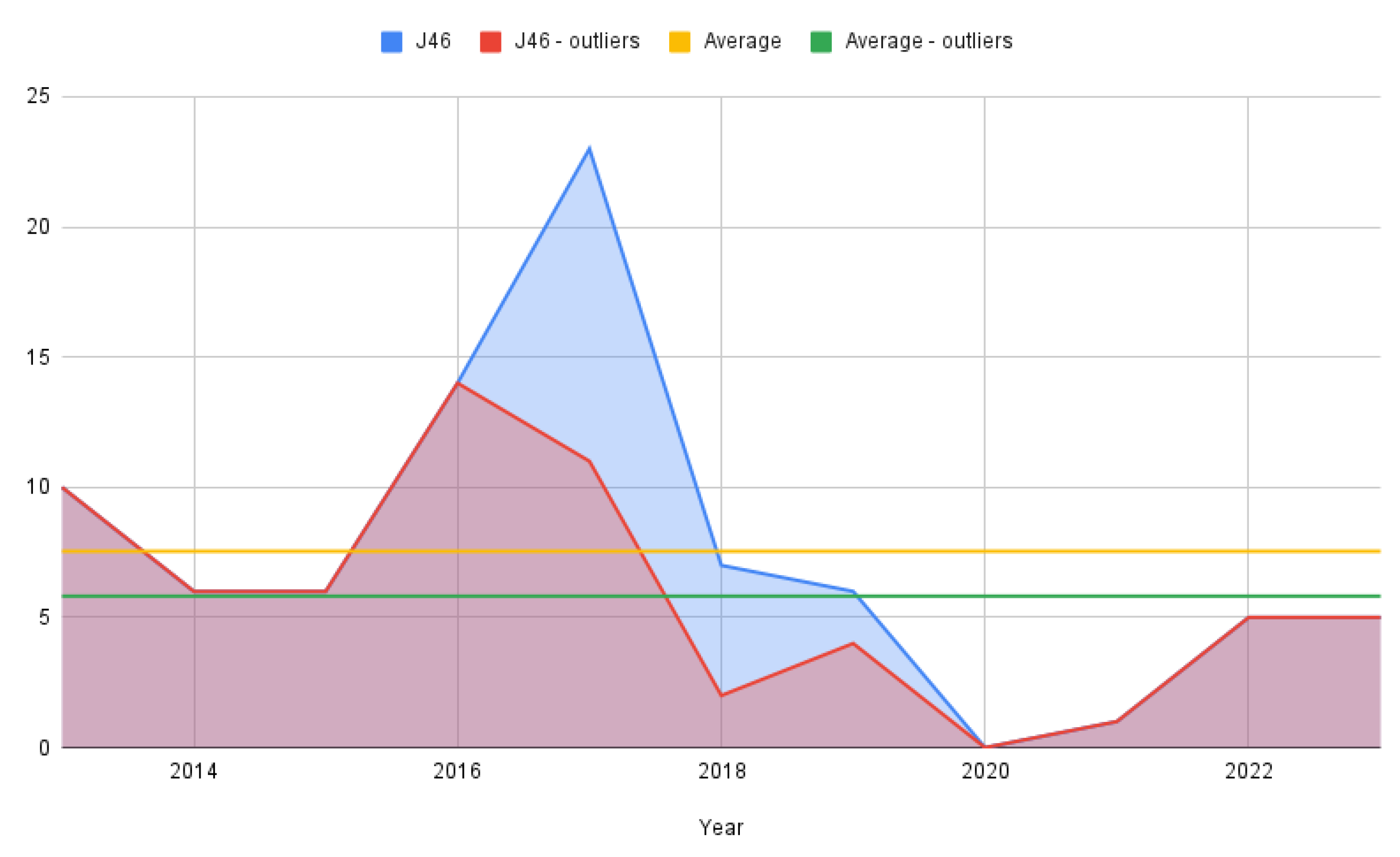
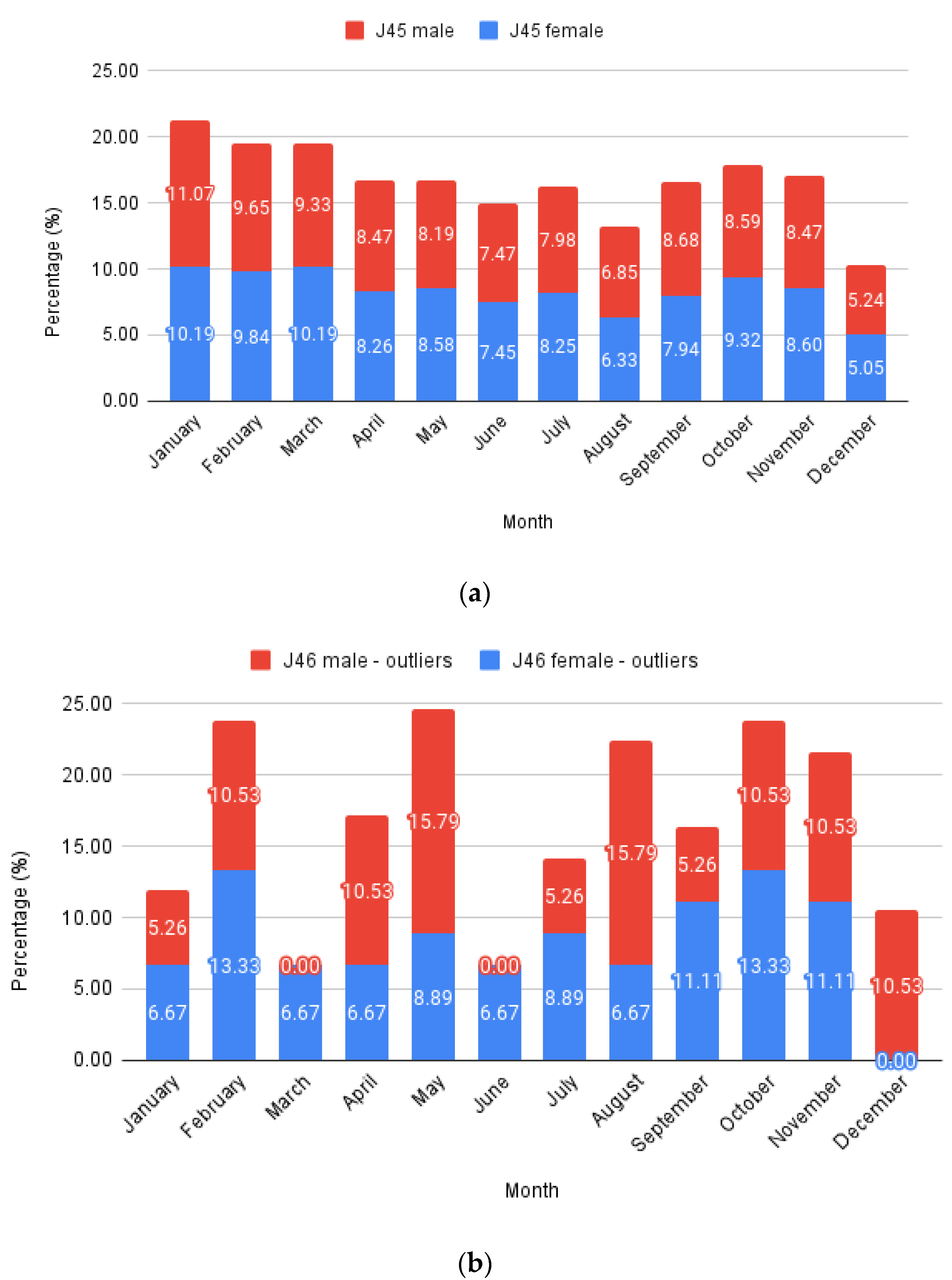
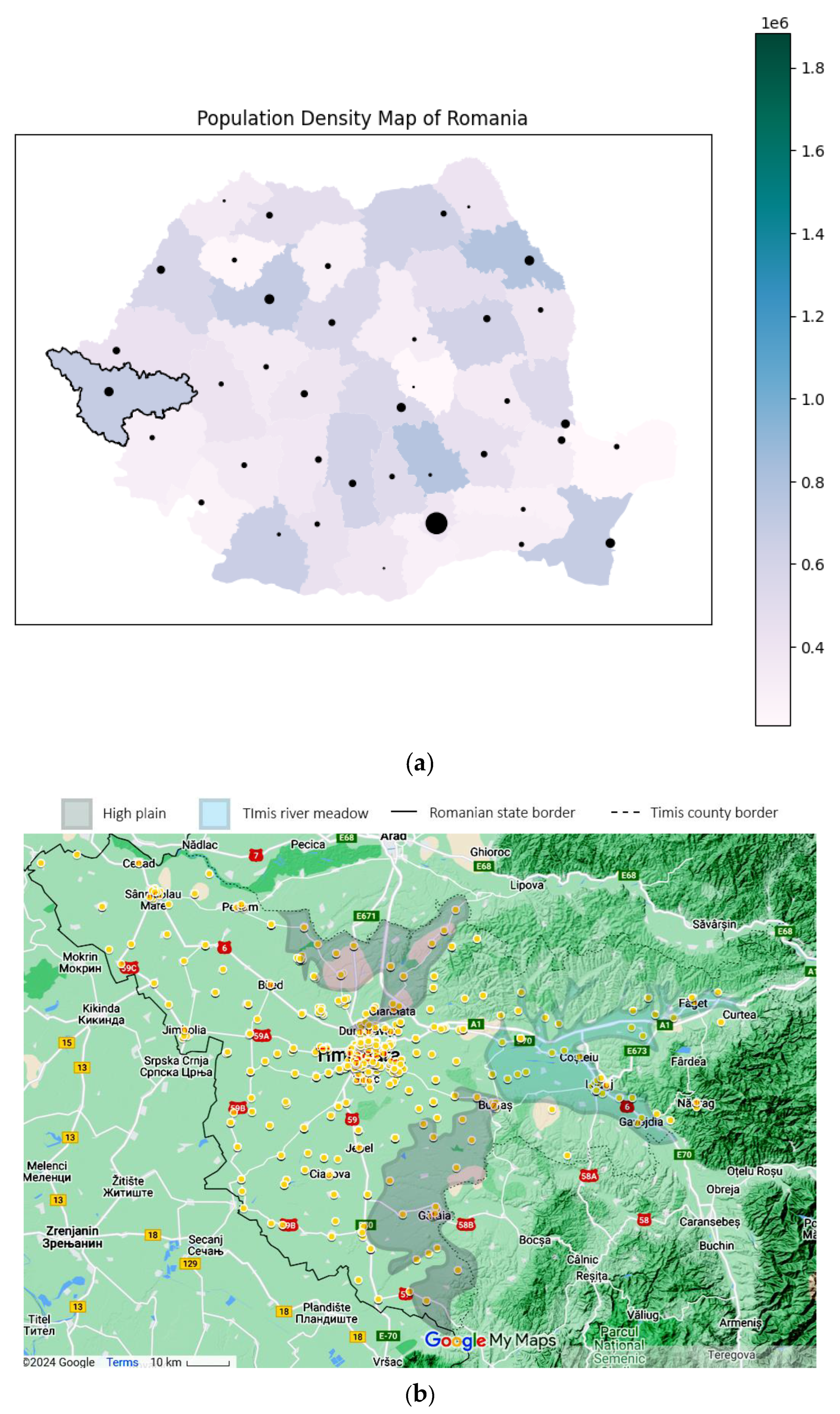


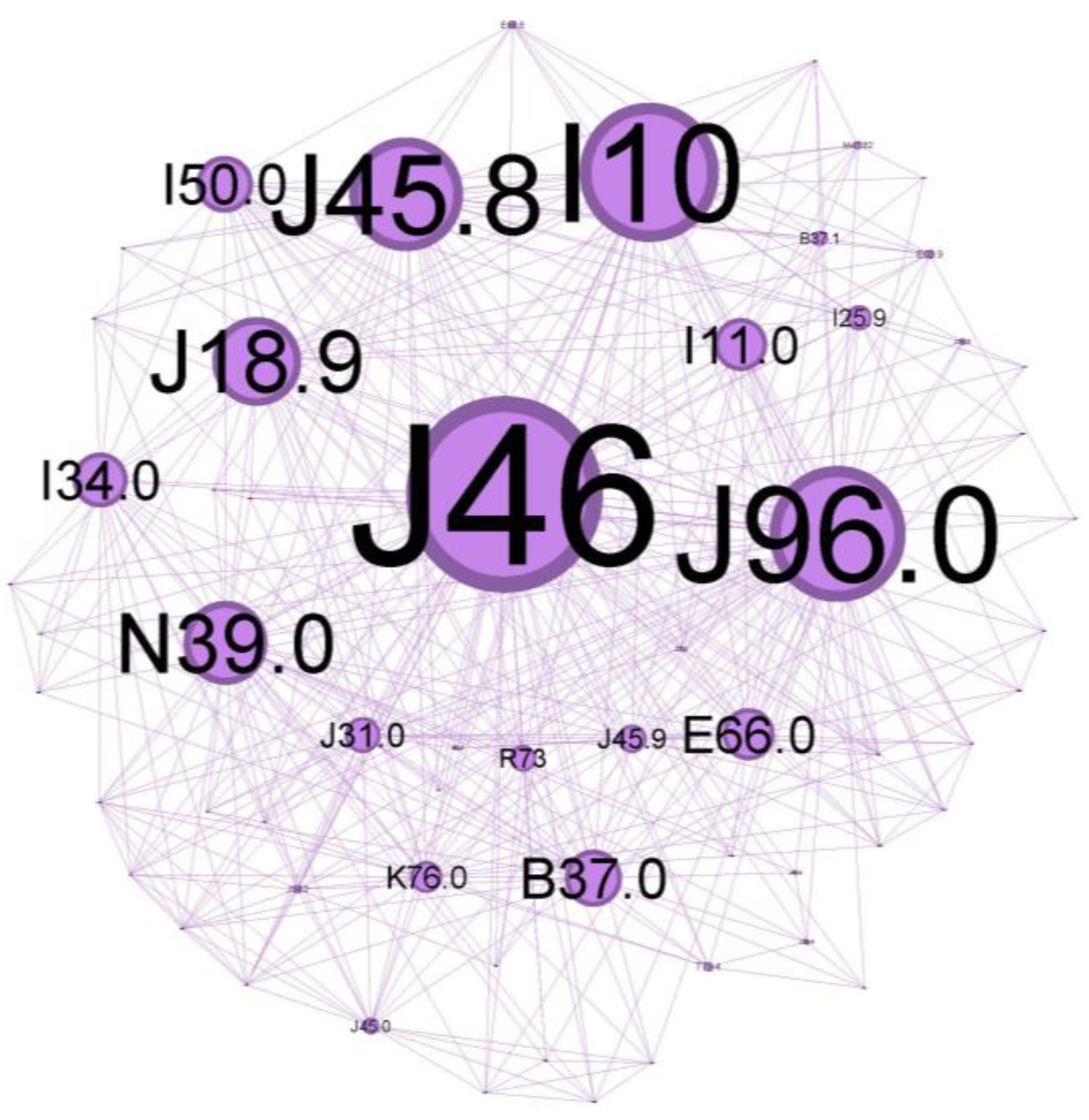
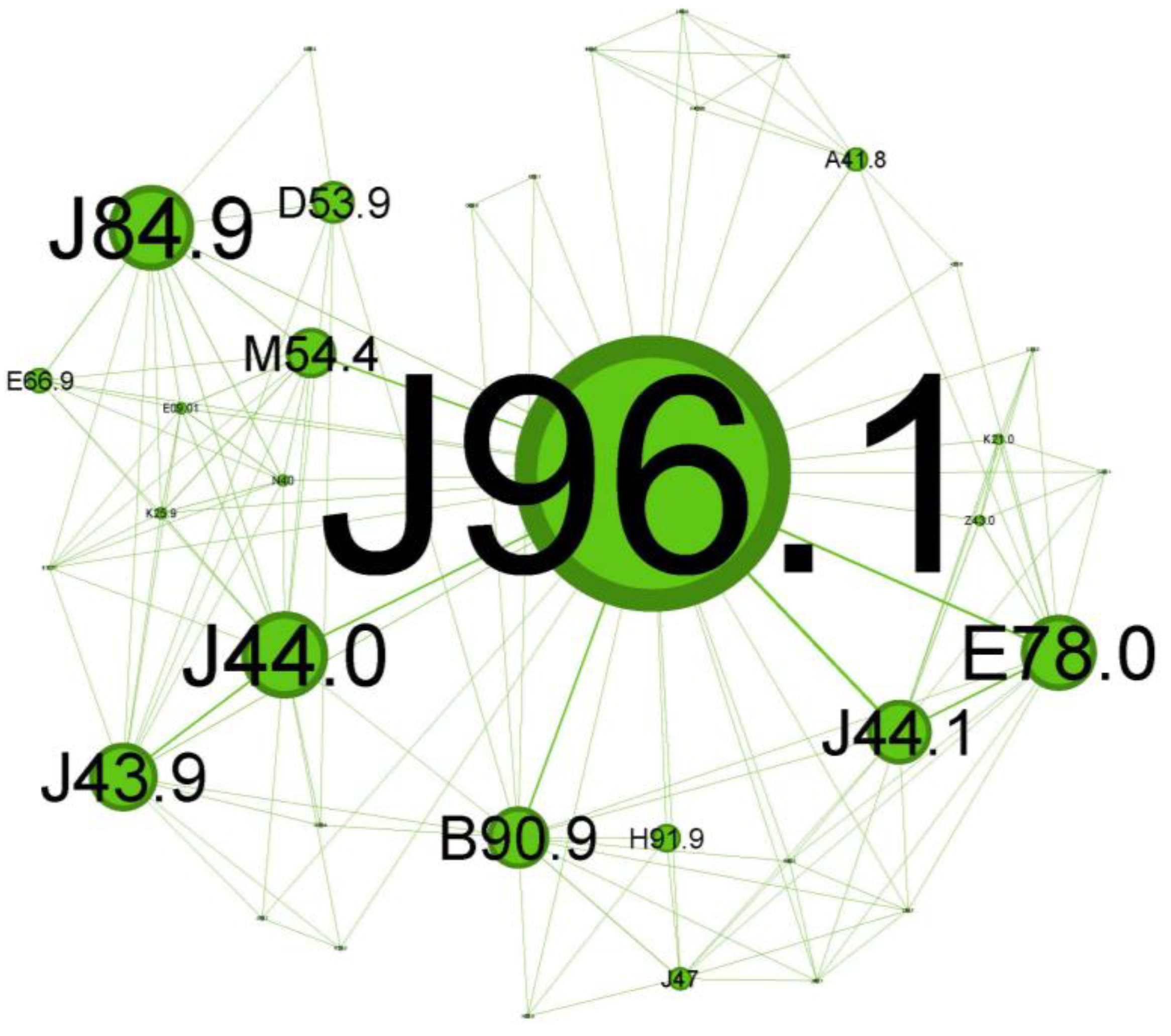
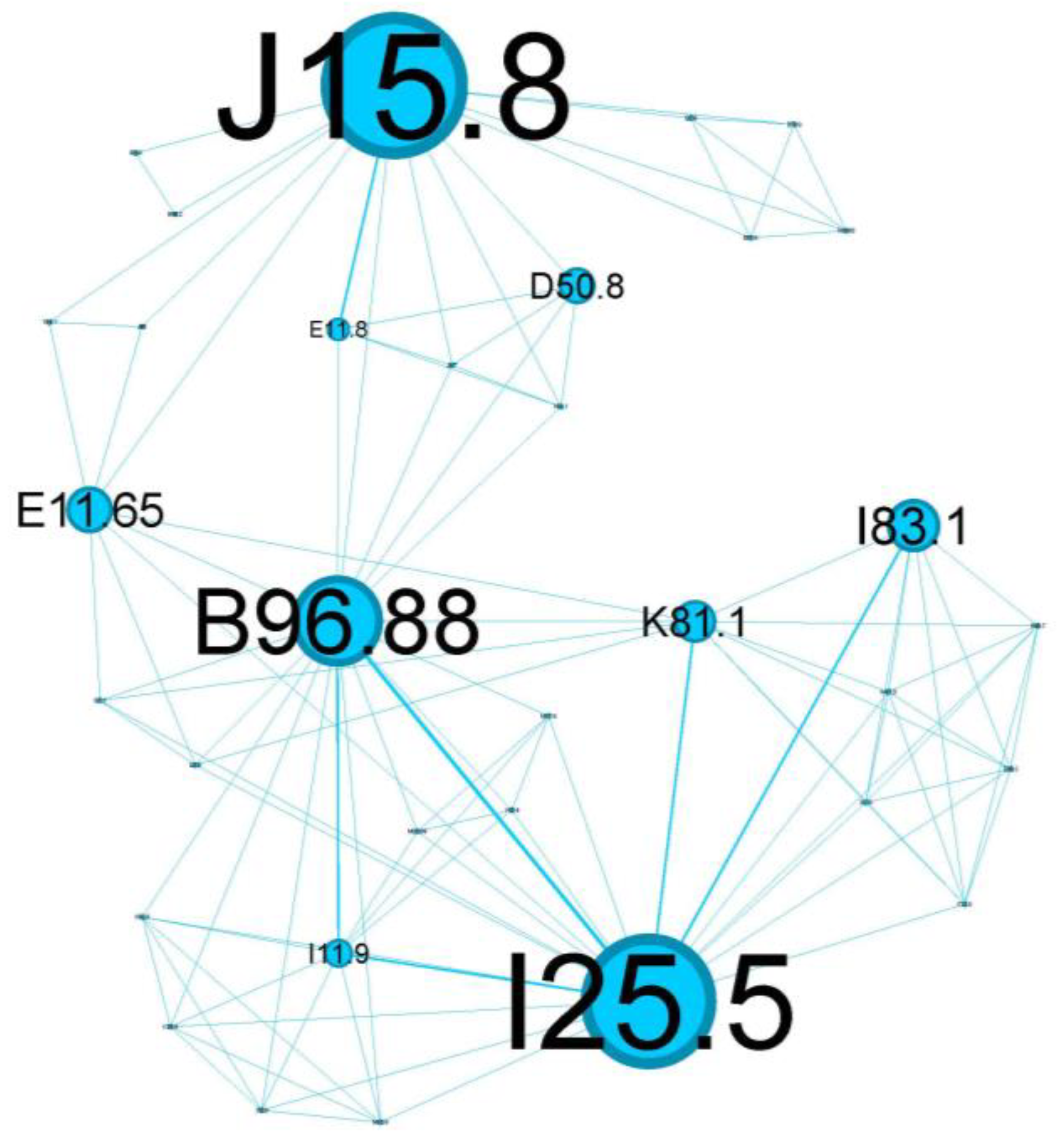
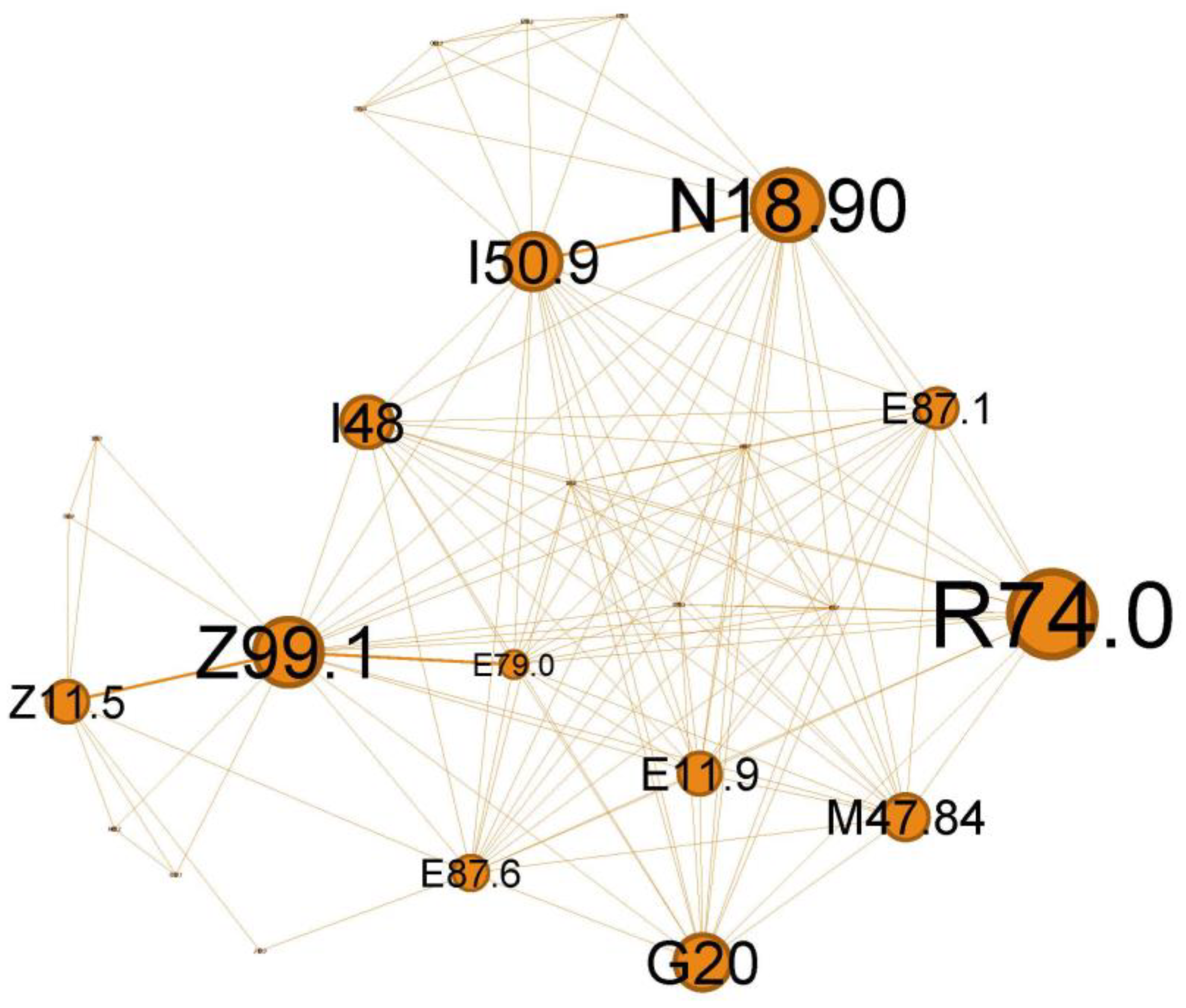


| Endotype | Phenotypes | Age/Onset | Substrate/Comorbidities | Response to Treatment | Source |
|---|---|---|---|---|---|
| T2-high | Atopic allergic | Early | Increased serum-specific IgE | Good with corticosteroid | [11] |
| Eosinophilic | Late-adult onset | Chronic rhinosinusitis with nasal polyps (CRSwNP) | Steroid-resistant | [12] | |
| T2-low | Non-atopic neutrophilic | Adult | Obesity, smoking, and persistent infection with atypical bacteria (Mycoplasma pneumoniae and Chlamydophila pneumoniae) | Steroid-resistant | [11] |
| Smokers | Older | Frequent exacerbation, lower lung function, | Steroid-resistant | [13] | |
| Obesity-associated | Middle-aged, women | Severe symptoms; average preserved function | Steroid-refractory | [13,14] | |
| Neutrophilic | Geriatric | Immunosenescence | [15] | ||
| Unclear | “Dutch hypothesis” or Overlap | Adult | Hypertension, elevated cholesterol/hyperlipidemia, arthritis, depression, obesity, gastroesophageal reflux disease | [16] |
| Measurement | Age | Length of Stay | ||
|---|---|---|---|---|
| J46 | J45 | J46 | J45 | |
| Count | 83 | 13612 | 83 | 13612 |
| Mean | 57.590 | 59.619 | 6.024 | 4.484 |
| Standard deviation | 15.957 | 14.813 | 4.983 | 5.941 |
| Minimum value | 20 | 18 | 0 | 0 |
| First quartile (25%) | 46 | 51 | 1 | 0 |
| Median quartile (50%) | 59 | 62 | 6 | 1 |
| Third quartile (75%) | 71 | 70 | 9 | 8 |
| Maximum value | 88 | 95 | 20 | 7 |
| Skewness | −0.260 | −0.567 | −0.597 | 1.883 |
| Kurtosis | −0.508 | −0.044 | −0.088 | 5.854 |
| NO2 | O3 | PM2.5 | PM10 | J45 | J46 | |
|---|---|---|---|---|---|---|
| J45 | 0.389 | −0.051 | 0.576 | 0.684 | 1 | 0.116 |
| J46 | −0.061 | −0.305 | 0.373 | 0.366 | 0.116 | 1 |
| No. | Cluster | Nodes | Edges | Connections to | |||||
|---|---|---|---|---|---|---|---|---|---|
| Purple | Green | Blue | Orange | Teal | Pink | ||||
| 1 | Purple | 60 | 416 | - | 134 | 204 | 174 | 87 | 12 |
| 2 | Green | 36 | 138 | 134 | - | 49 | 27 | 20 | 4 |
| 3 | Blue | 33 | 108 | 204 | 49 | - | 15 | 5 | 0 |
| 4 | Orange | 25 | 133 | 174 | 27 | 15 | - | 5 | 0 |
| 5 | Teal | 16 | 58 | 87 | 20 | 5 | 5 | - | 0 |
| 6 | Pink | 4 | 6 | 12 | 4 | 0 | 0 | - | |
| Color | Presumed Endotype | Clinical Phenotypes | Substrate/Comorbidities | % | Recommended Attitude/Treatment |
|---|---|---|---|---|---|
| Purple | T2-high | High inflammatory status | Inadequate disease control, metabolic syndrome, heart disease with long-term cardiovascular deficiency | 34.48% |
|
| Orange | T2-high | Infections | Oxygen therapy, pre-existing chronic pathology (cardiovascular, renal, neurological, and liver failure) | 14.37% |
|
| Green | T2-low | Senescence | Interstitial lung disease, bronchiectasis, emphysema | 20.69% |
|
| Blue | T2-low (maybe?) | Poorly controlled diabetes | Aggressive lung parenchyma infection cycle, ischemic heart disease | 18.97% |
|
| Teal | Overlap | Asthma/COPD | Smoking, secondary pulmonary hypertension | 9.2% |
|
Disclaimer/Publisher’s Note: The statements, opinions and data contained in all publications are solely those of the individual author(s) and contributor(s) and not of MDPI and/or the editor(s). MDPI and/or the editor(s) disclaim responsibility for any injury to people or property resulting from any ideas, methods, instructions or products referred to in the content. |
© 2024 by the authors. Licensee MDPI, Basel, Switzerland. This article is an open access article distributed under the terms and conditions of the Creative Commons Attribution (CC BY) license (https://creativecommons.org/licenses/by/4.0/).
Share and Cite
Trusculescu, A.A.; Ancusa, V.M.; Pescaru, C.C.; Wellmann, N.; Fira-Mladinescu, C.; Oancea, C.I.; Fira-Mladinescu, O. A Multifaceted Exploration of Status Asthmaticus: A Retrospective Analysis in a Romanian Hospital. J. Clin. Med. 2024, 13, 6615. https://doi.org/10.3390/jcm13216615
Trusculescu AA, Ancusa VM, Pescaru CC, Wellmann N, Fira-Mladinescu C, Oancea CI, Fira-Mladinescu O. A Multifaceted Exploration of Status Asthmaticus: A Retrospective Analysis in a Romanian Hospital. Journal of Clinical Medicine. 2024; 13(21):6615. https://doi.org/10.3390/jcm13216615
Chicago/Turabian StyleTrusculescu, Adriana Ana, Versavia Maria Ancusa, Camelia Corina Pescaru, Norbert Wellmann, Corneluta Fira-Mladinescu, Cristian Iulian Oancea, and Ovidiu Fira-Mladinescu. 2024. "A Multifaceted Exploration of Status Asthmaticus: A Retrospective Analysis in a Romanian Hospital" Journal of Clinical Medicine 13, no. 21: 6615. https://doi.org/10.3390/jcm13216615
APA StyleTrusculescu, A. A., Ancusa, V. M., Pescaru, C. C., Wellmann, N., Fira-Mladinescu, C., Oancea, C. I., & Fira-Mladinescu, O. (2024). A Multifaceted Exploration of Status Asthmaticus: A Retrospective Analysis in a Romanian Hospital. Journal of Clinical Medicine, 13(21), 6615. https://doi.org/10.3390/jcm13216615









